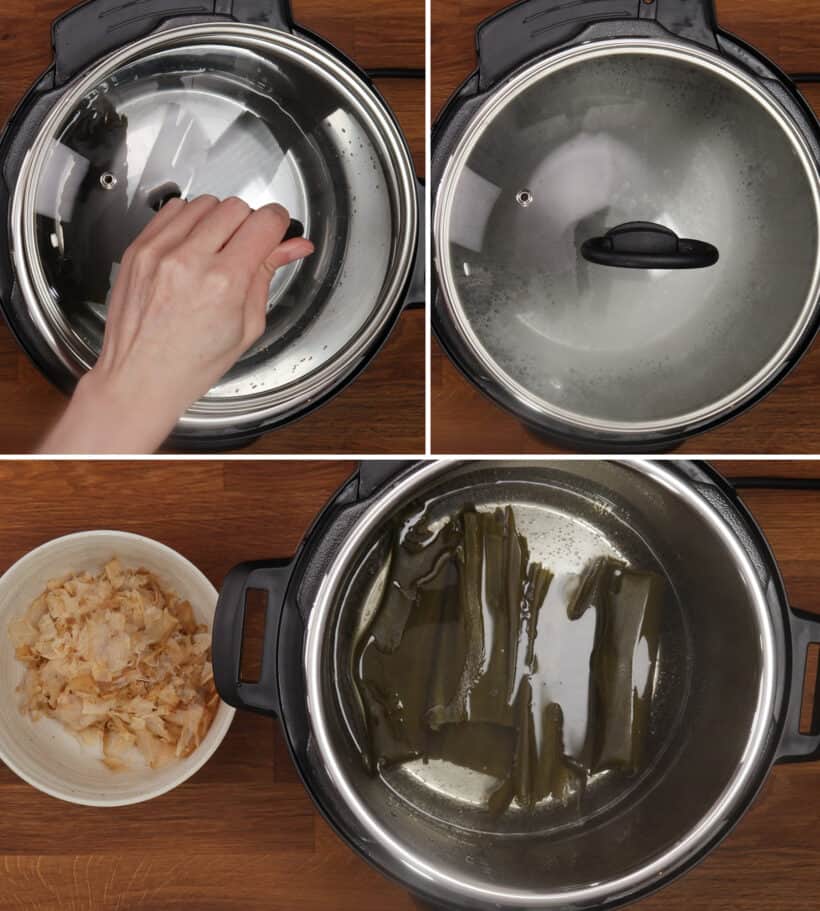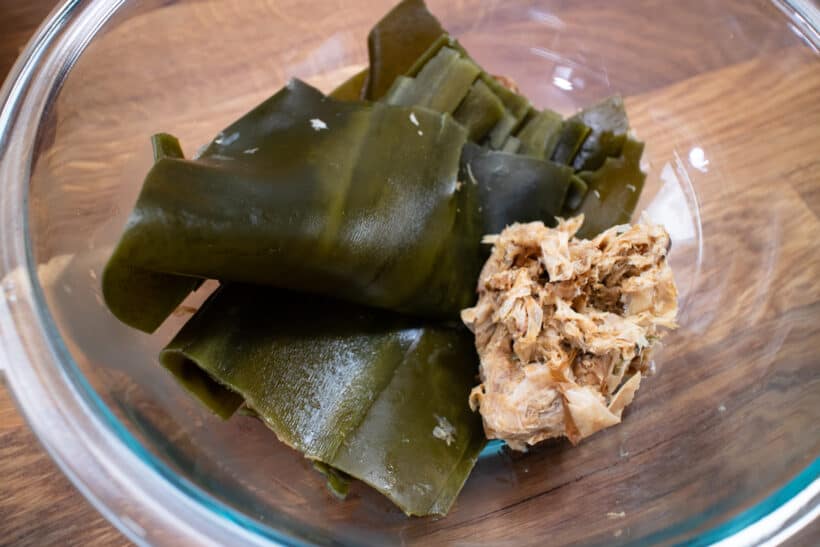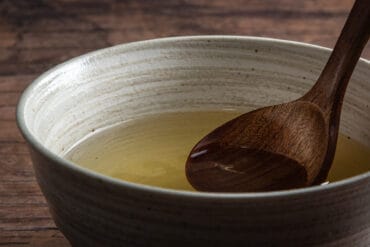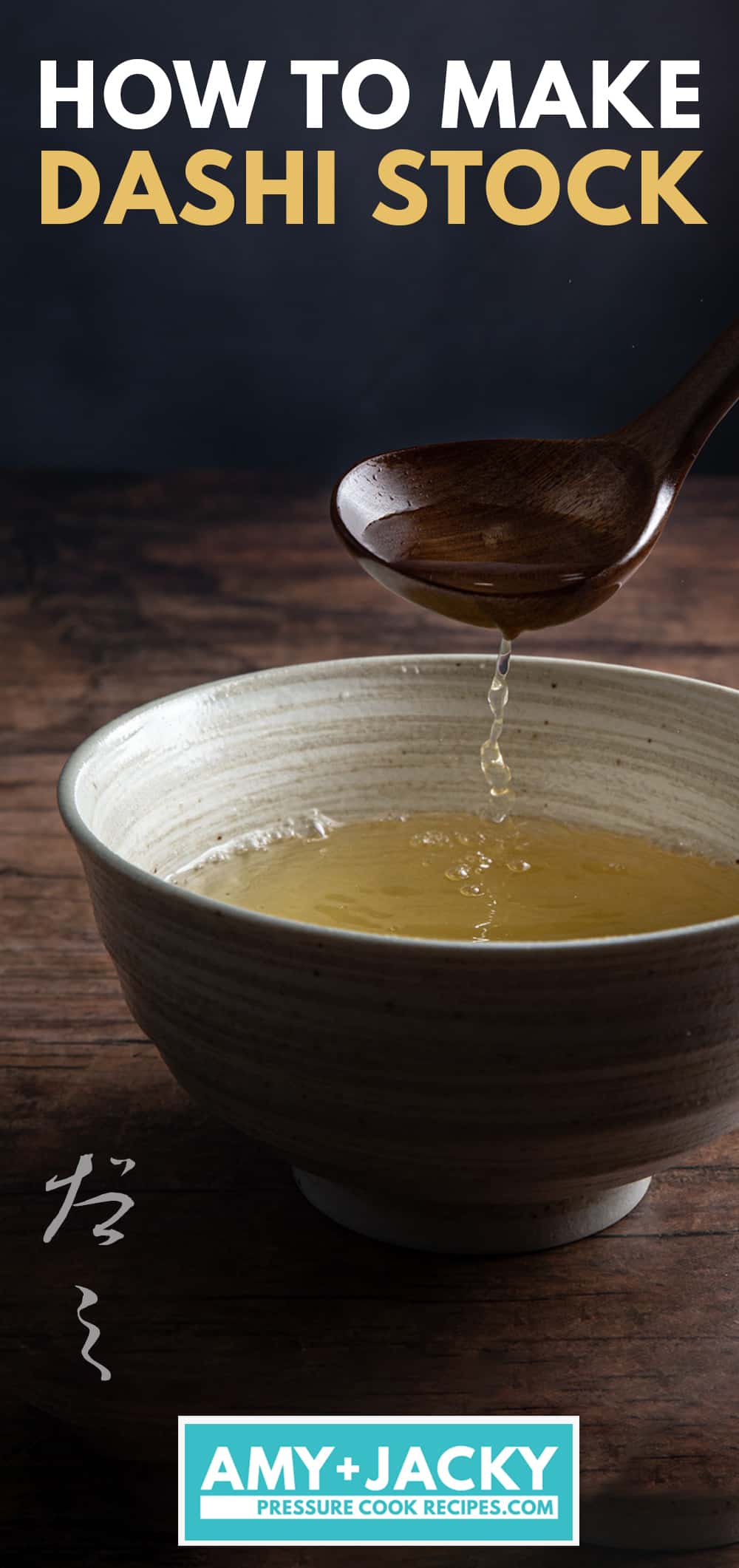Learn how to make Dashi (だし, 出汁) with 3 ingredients in 3 simple steps. Super easy to make this versatile dashi stock that is the soul of many Japanese dishes. Get ready to enjoy many delicious dishes using this intense umami-bombing elixir!
How to Make Dashi Guide
- What is Dashi
- Ingredients to Make Dashi
- How to Make Dashi
- Tools to Make Dashi
- Dashi Substitute
- What is Instant Dashi
- Dashi Experiment
- Step-by-Step Photo Guide
- What Can I Make with Dashi
- How to Store Dashi

What is Dashi?
Dashi (Japanese: だし, 出汁) is a Japanese clear stock. It’s packed with clean, distinct umami (savory) flavor, with a slightly smoky flavor of the sea.
Umami flavor is commonly found in food such as meats, cheese, tomatoes, mushrooms, fish, shellfish, soy-based foods, and seaweed.
Basic dashi stock is mainly made by steeping kombu (昆布 or dried kelp) and dried bonito flakes in water.
This simple stock is one of the basic fundamentals of Japanese cuisine. Some would even say, it’s the soul of many Japanese dishes. As an intense umami elixir, it works magic to enrich & boost the depth of a dish.
It’s a very versatile base stock for many Japanese soups, broths, sauces, and stews such as miso soup, udon soup, soba soup, oden, or sukiyaki.
Nowadays, even top European chefs are beginning to fall in love with this Japanese stock & incorporating it into their recipes.
Japanese Dashi is a bit similar to Yuksu – a type of Korean style basic anchovy stock for creating a base broth for Korean soups, jjigae stews, and noodle dishes.

What Ingredients are in Dashi?

There are three main ingredients in this basic yet versatile dashi stock.
- Kombu
- Dried bonito flakes
- Water
*Note: Since the flavor, aroma, clarity, & body of dashi depend on these 3 ingredients, try to use high-quality ingredients for the best results.
Kombu 昆布

Kombu (Japanese: 昆布) is dried kelp found in countries like Japan, Australia, South Africa, China, and Russia.
There are 6 – 7 main species of kombu from Japan, mostly harvested in Hokkaido (Japanese: 北海道). These includes Ma-Kombu, Rishiri-Kombu, Rausu-Kombu, Hidaka-Kombu, Hosome-Kombu, Naga-Kombu, and Saomae-Kombu.
Different species of Kombu can vary in different characteristics:
- Sizes & Shapes: thick & wide or thin & long
- Colors: light brown, dark brown, blackish dark green, black, grayish-black
- Textures: hard, soft, slippery
- Tastes: sweeter, saltier, fragrant
- Usage: some kombu is great for making a clear broth, some are great for making kobu-cha (kombu tea), while others are great for making a rich broth
Some Michelin-star chefs who aim to take their dashi to the next level use a combination of different high-quality kombu & freshly-shaved Katsuobushi for extra complexity, flavor, & aroma.
For this Dashi Recipe, we used Hidaka-Kombu (Dried Kelp from Hidaka Hokkaido Japan) because it’s affordable and widely available in North America.
*Pro Tip: You might find some white chalky powdery substance on the kombu’s surface. They’re an umami substance – flavor-enhancing compounds. So please do not dust or wash it off!
Dried Bonito Flakes 鰹節

Bonito is skipjack tuna. Katsuobushi (Japanese: 鰹節 aka bonito flakes) is simmered, dried, smoked, and fermented bonito. The sun-dried process will increase the tuna’s hardness and dryness until it resembles a piece of wood.
*Note: If you’re lucky enough to try one of these whole Honkarebushi Katsuobushi block, don’t forget to buy this Katsuobushi kezuriki - Katsuobushi Shaver Tool.
They’re smoky and pack with lots of umami (savory) flavors. They contain a high amount of protein, and rich in vitamins and minerals.
It’s an extremely versatile seasoning and topping for dishes like Okonomiyaki, Takoyaki, or Agedashi Tofu.

There are different types of Bonito Flakes. We used the Regular Hana Katsuo (Japanese: 花鰹 or 花かつお) to develop this recipe because it’s more affordable and widely available. They’re wider, thin, horizontal shavings. It’s a good choice for making Japanese dashi stock, miso soup, topping for okonomiyaki, and takoyaki.
You can also use Shaved Karebushi or Arakezuri if you’re able to find them!
How to Make Dashi?
The process to make dashi is simply extracting the flavor-enhancing substance from kombu & bonito flakes. It’s very easy & simple:
- Steep kombu in water
- Steep bonito flakes in the kombu water
- Drain dashi to use
*Note: Though it’s a very simple process, there are various theories and techniques on how to make the best dashi. It’s especially important to closely follow the steps because high heat can spoil the stock by making it cloudy and bitter-tasting.
Tools You Need
- Instant Pot or 2 – 3QT saucepan.
- Fine Mesh Strainer
- Pyrex Measuring Cups
- Silicone Spatula
Dashi Substitute
If possible, try your best to use homemade dashi when called for in a recipe. But if you’re short on time or are looking for alternatives. Here are 3 dashi substitute options:
- Instant dashi – HonDashi
- Shiitake mushroom kombu stock
- Yuksu (Korean Style Dashi) – a type of basic anchovy stock

What is Instant Dashi?

If you don’t have access to high-quality kombu or dried bonito flakes, you can buy instant dashi or dashi powder as a substitute: Hondashi (Bonito Soup Stock)
However, after conducting a blind taste test comparing homemade dashi with Instant Dashi, there’s quite a big difference in flavors, aroma, richness, and depth of flavors.
So this simple extra step to make your own definitely goes a long way to achieve a better tasting dish!
Dashi Experiment
In this experiment, we aim to find the optimal steeping time to make dashi for the particular kombu and dried bonito flakes we used.
So we steeped the ingredients for different times, then we did a blind taste test to see which stock had the best flavors & aroma.
You might be thinking: “Hey! I can’t see anything in the bowls in the photo below.” hehe~ yes! We used clear bowls because we didn’t want the stock’s color to influence what we thought of each sample.
*Note: If you are using another type of kombu, please use this as a reference only.

Experiment Results
- 5 minutes – light, delicate, slightly aromatic, umami flavor
- 6 minutes – slightly stronger than 5 mins version, but the flavor is still a bit too light
- 7 minutes – beginning to have a strong enough umami flavor
- 8 minutes & 9 minutes – stronger & more aromatic umami flavors than the previous versions
- 10 minutes – much stronger & more flavorful than the 5 mins version, has a quite strong smoky, umami flavor
Conclusion: There’s a noticeable difference between “5 to 6 minutes” versions with “7 to 10 minutes” versions. Both of us thought the “7 to 10 minutes” versions are the sweet spot.
Step-by-Step Guide: How to Make Dashi

Add Kombu and Water in Pot
First, add 12g dried kombu and 4 cups (1L) cold water in your Instant Pot or saucepan.
*Note: If you see some white powdery substance on your kombu, do not wash or dust it off!

Instant Pot: use the “Saute Normal” function. If your Instant Pot doesn’t have “Saute normal”, you can use “Saute Low” function instead. Cover the pot with a glass lid.
Saucepan: turn heat to medium-low.

When the liquid is barely simmering, immediately turn off the heat.
*Note: This should take roughly 10 to 11 minutes.

Add Bonito Flakes
Now, add and submerge 15g dried bonito flakes in the stock mixture.

If you’re using the Instant Pot or an electric stove, transfer the pot to the countertop.
Close the lid, then allow it to steep for 7 to 10 minutes.

Strain Kombu and Bonito Flakes
Open the lid, then pour the stock mixture into another container through a fine-meshed strainer.

Finally, squeeze all the absorbed stock out of the bonito flakes.
Ready to Use
Ta da! Your dashi is ready to be used as a stock!

*Pro Tip: Don’t throw away the kombu and dried bonito flakes because they’re completely edible. Also, you can use them one more time to make milder dashi, aka Niban Dashi (Japanese: 二番だし) or in a side dish.

What Can I Make with Dashi
Can I Double This Recipe
Yes! You can double all the ingredients while keeping the steeping time the same.
How to Store Dashi
Fridge: Pour the stock into mason jars & store them in the fridge. It’ll keep in the fridge for up to 4 to 5 days.
Freezer: You can store the dashi in the freezer for long-term storage. You can freeze the stock in these silicone molds (shown in the photo below). After they freeze in the mold, you can easily pop them out, and store them in ziploc freezer bags.
Here’s a sample photo from our Chicken Stock Recipe:

*Note: This silicone mold makes great portions that can thaw quickly. It’s very convenient to use and easy to wash.
Have fun using Dashi to make tasty Japanese dishes!

How to Make Dashi
Ingredients
- 1 liter (4 cups) cold water
- 2 pieces (12g) dried kombu
- 15 grams dried bonito flakes
♥ Share this Recipe so We can create more yummy recipes for you. Thank you 🙂
Instructions
- Add Kombu and Water in Pot: Add 12g dried kombu and 4 cups (1L) cold water in Instant Pot or saucepan. Instant Pot: use "Saute Normal" function. Alternatively, use "Saute Low" function. Cover the pot with a glass lid. Saucepan: turn heat to medium-low. When the liquid is barely simmering, immediately turn off the heat. *Note: This should take roughly 10 to 11 minutes.
- Add Bonito Flakes in Dashi: Submerge 15g dried bonito flakes in dashi mixture. If you're using the Instant Pot or an electric stove, transfer the pot to the countertop. Close the lid, then allow it to steep for 7 to 10 minutes.
- Strain Kombu and Bonito Flakes: Open the lid, then pour the dashi mixture into another container through a fine-meshed strainer. Squeeze all the absorbed dashi out of the bonito flakes.
- Use Dashi: Your dashi is ready to be used as a stock! *Pro Tip: Don't throw away the kombu and dried bonito flakes because they're completely edible. You can use them one more time to make milder dashi or in a side dish.
Notes
- Fridge: Pour the dashi into a mason jar & store it in the fridge. It'll keep in the fridge for up to 4 to 5 days.
- Freezer: You can freeze the stock in silicone molds, pop them out, and store them in ziploc freezer bags.
Nutrition
All Our Pressure Cooker Recipes
*Disclosure: We are an Amazon Influencer/Amazon Associate. This means that if you decide to purchase items or services on Amazon through our links on Pressure Cook Recipes to Amazon, Amazon will send a small commission to us at no additional costs to you. Thank you!




